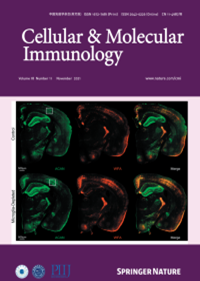Cell-associated galectin 9 interacts with cytotoxic T cells confers resistance to tumor killing in nasopharyngeal carcinoma through autophagy activation
IF 19.8
1区 医学
Q1 IMMUNOLOGY
引用次数: 0
Abstract
Immune effector cells, including cytotoxic T lymphocytes (CTLs) play essential roles in eliminating cancer cells. However, their functionality is often compromised, even when they infiltrate the tumor microenvironment (TME) or are transferred to cancer patients adoptively. In this study, we focused on galectin 9 (G9), an inhibitory ligand that we observed to be predominately positioned on the plasma membrane and readily interacts with CD8 + CTL in the TME of nasopharyngeal carcinoma (NPC). We discovered that cell-cell contact between activated effector CTLs and target tumor cells (TarTC) with G9 overexpression led to cellular death defects. Despite the formation of CTL–TarTC conjugates, there is no impact on the cell number nor viability of CTL, and the release of cytolytic content and associated activity were not completely abrogated. Instead, this interaction promoted autophagy and restricted necrosis in the TarTC. Furthermore, reducing G9 expression in tumor cells enhanced the suppressive effect on tumor growth upon adoptive transfer of activated effector CTL. Additionally, inhibiting autophagy effectively controlled tumor growth in cases of G9 overexpression. Therefore, we highlight the contribution of G9 in facilitating the resistance of NPC to CTL-mediated killing by inducing a selection-cell death state in tumor cells, characterized by increased autophagy and decreased necrosis.

细胞相关凝集素9与细胞毒性T细胞相互作用,通过自噬激活来抵抗鼻咽癌的肿瘤杀伤。
免疫效应细胞,包括细胞毒性T淋巴细胞(ctl)在消除癌细胞中发挥重要作用。然而,即使它们渗透到肿瘤微环境(TME)或被转移到癌症患者体内,它们的功能也经常受到损害。在这项研究中,我们重点研究了凝集素9 (G9),这是一种抑制配体,我们观察到它主要位于质膜上,并且在鼻咽癌(NPC)的TME中很容易与CD8 + CTL相互作用。我们发现激活的效应ctl与G9过表达的靶肿瘤细胞(TarTC)之间的细胞-细胞接触导致细胞死亡缺陷。尽管形成CTL- tartc偶联物,但对CTL的细胞数量和活力没有影响,并且细胞溶解物的释放和相关活性并未完全取消。相反,这种相互作用促进了TarTC的自噬并限制了坏死。此外,降低肿瘤细胞中G9的表达增强了激活效应CTL过继转移对肿瘤生长的抑制作用。此外,抑制自噬可以有效地控制G9过表达病例的肿瘤生长。因此,我们强调G9通过诱导肿瘤细胞的选择细胞死亡状态,以增加自噬和减少坏死为特征,促进NPC抵抗ctl介导的杀伤。
本文章由计算机程序翻译,如有差异,请以英文原文为准。
求助全文
约1分钟内获得全文
求助全文
来源期刊
CiteScore
31.20
自引率
1.20%
发文量
903
审稿时长
1 months
期刊介绍:
Cellular & Molecular Immunology, a monthly journal from the Chinese Society of Immunology and the University of Science and Technology of China, serves as a comprehensive platform covering both basic immunology research and clinical applications. The journal publishes a variety of article types, including Articles, Review Articles, Mini Reviews, and Short Communications, focusing on diverse aspects of cellular and molecular immunology.

 求助内容:
求助内容: 应助结果提醒方式:
应助结果提醒方式:


